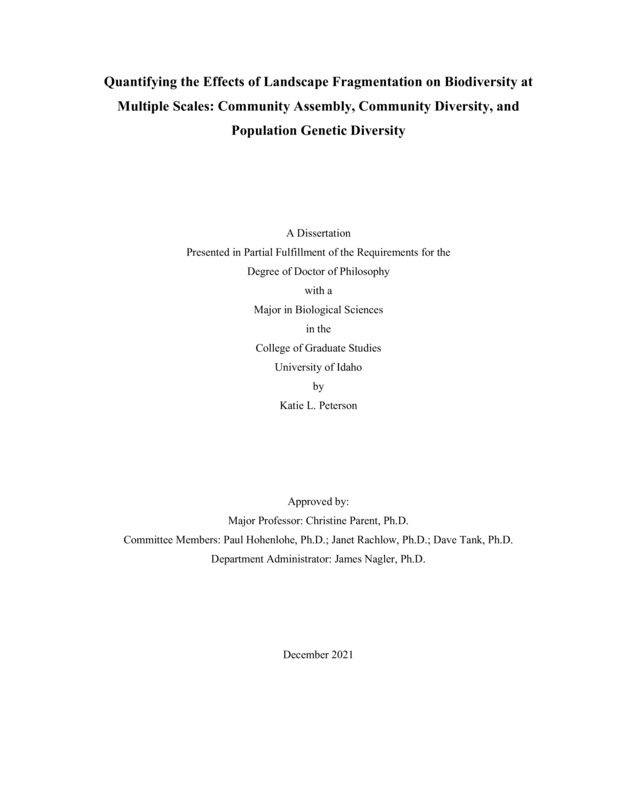Quantifying the Effects of Landscape Fragmentation on Biodiversity at Multiple Scales: Community Assembly, Community Diversity, and Population Genetic Diversity
Peterson, Katie. (2021-12). Quantifying the Effects of Landscape Fragmentation on Biodiversity at Multiple Scales: Community Assembly, Community Diversity, and Population Genetic Diversity. Theses and Dissertations Collection, University of Idaho Library Digital Collections. https://www.lib.uidaho.edu/digital/etd/items/peterson_idaho_0089e_12282.html
- Title:
- Quantifying the Effects of Landscape Fragmentation on Biodiversity at Multiple Scales: Community Assembly, Community Diversity, and Population Genetic Diversity
- Author:
- Peterson, Katie
- ORCID:
- 0000-0003-4401-4941
- Date:
- 2021-12
- Program:
- Biology
- Subject Category:
- Biology
- Abstract:
-
We observe the continued human alteration to natural landscapes around us, fragmenting and isolating populations, yet it remains a challenge to identify the evolutionary processes that are involved and make predictions on the impacts that fragmentation has on community assembly and disassembly processes. These predictions are made increasingly difficult as these impacts are species dependent. In this dissertation I use phylogenetic and genomic tools to quantify the impacts of fragmentation on biodiversity at multiple organizational scales. For this work I have collaborated with researchers to use a combination of techniques, for example, species traits, the relatedness of species to compare species assemblages, and DNA as a tool to be able to infer population level differences. My goal is to quantify the impacts of fragmentation on biodiversity at different scales and identify evolutionary processes that are influencing insular, or seemingly isolated, populations and communities. Further, in my chosen study system of Craters of the Moon National Monument and Preserve (CRMO) in Idaho, I, and my collaborators, can ask and answer questions related to the assembly of communities and the disassembly of communities in fragmented populations. With this work we can inform conservation and restoration efforts, particularly in isolated populations. Thus, science communication and scientific literacy are integral to the scientific process.In Chapter 1, I focus on community level processes, using phylogenies as a tool to quantify the relatedness of species and a trait of interest. Using the community of vascular plants, we compare those species found in insular communities to the species in a larger pool that could potentially inhabit the isolated habitats to test for the impact of a range of factors on the membership of a species in a community. To this end, we use both traditional metrics and a new machine learning approach. With the traditional metrics we inferred neutral processes as important for shaping the insular communities at CRMO. However, with a proposed novel approach we inferred the joint influence of neutral and filtering processes. In Chapter 2, the focus is on the species level impact of fragmentation. Populations of an individual species may be impacted by changes in isolation brought on my fragmentation and may also become isolated genetically. I, along with my collaborators, use DNA as a tool to infer population level changes in a species of crab spider, Mecaphesa celer. This allows us to infer potential impacts to gene flow among separated populations. From this first genome-wide assessment of M. celer at CRMO we do not detect clustering or genetic structure between the isolated populations, so genetically it is as if the spiders are one population. This means high amounts of gene flow exist between the isolated habitats and potentially the neighboring areas as well. In Chapter 3, I describe a community outreach series called Science After Hours that I created and coordinated. I describe its impacts and provide information on the replication of a similar program. As scientists our knowledge is worthless if not shared, as learning does not occur in a vacuum. Sharing our work allows for informed actions and decisions. Science communication is an imperative, integral role for researchers and few low risk, small time commitment opportunities exist. This program filled a need in the Moscow, ID and Pullman, WA community and brought together stakeholders from the community, local businesses, and researchers. Through this work we were able to quantify the impacts of fragmentation on biodiversity at different scales and identify evolutionary processes that are influencing insular, or seemingly isolated, populations and communities at CRMO. Neutral and filtering processes dominate the community assembly process for the vascular plant communities and high amounts of gene flow in M. celer indicate little population structure in the species. By creating a science outreach series, I, along with other researchers in the Moscow and Pullman community were able to fulfill one aspect of our role as a scientist and share the importance of our work.
- Description:
- doctoral, Ph.D., Biology -- University of Idaho - College of Graduate Studies, 2021-12
- Major Professor:
- Parent, Christine E
- Committee:
- Hohenlohe, Paul; Rachlow, Janet; Tank, Dave; Nagler, James
- Defense Date:
- 2021-12
- Identifier:
- Peterson_idaho_0089E_12282
- Type:
- Text
- Format Original:
- Format:
- application/pdf
- Rights:
- In Copyright - Educational Use Permitted. For more information, please contact University of Idaho Library Special Collections and Archives Department at libspec@uidaho.edu.
- Standardized Rights:
- http://rightsstatements.org/vocab/InC-EDU/1.0/

